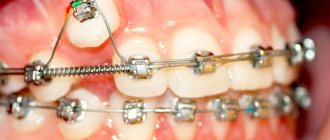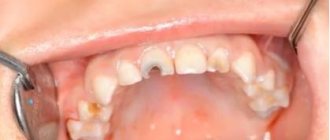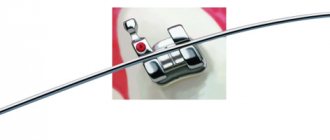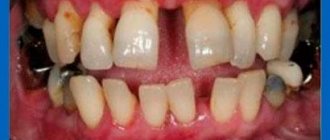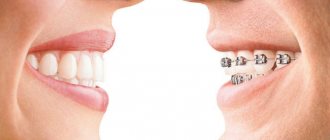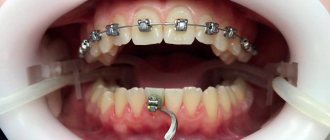Braces and gums
Causes of gum inflammation
Problems with gums with braces
Pulling a tooth out of the gum with braces
The main task of braces is to correct the bite and straighten the teeth. The system influences the teeth so that they move in the desired direction. Sometimes patients complain that their gums become inflamed during orthodontic treatment. What to do in such a situation?
Treatment and prevention of gum disease when correcting bite
- high-quality self-cleaning: you need to brush your teeth and remove special attention to your gums in the morning, in the evening, and also after every meal, including snacks. An irrigator is especially useful - a device that allows you to clean orthodontic appliances, teeth and gums with a jet of water under pressure,
- professional teeth cleaning and removal of dental plaque: in the vast majority of cases, the cause of periodontitis and periodontal disease is poor hygiene. Therefore, not only during treatment, but also in everyday life, it is recommended to carry out ultrasonic teeth cleaning 1-2 times a year, removing plaque and tartar from the teeth and from under the gums,
- anti-inflammatory treatment: includes rinsing the mouth with antiseptic solutions, applications with antimicrobial drugs and taking antibiotics,
- physiotherapy: the use of laser or electrophoresis will help quickly relieve inflammation,
- surgical intervention: a radical method that will help stop the development of the disease - its need is justified in case of severe detachment of the gum from the surface of the tooth and the appearance of mobility. During the operation, the gums are cut and the tooth root is cleaned of plaque and stone. When braces are installed, this method is not used, but if treatment is carried out using a removable structure, it can be easily removed from the mouth during the operation.
Damon Q metal braces - only RUR 72,000!
All inclusive! Preparation and treatment of the oral cavity, consultation with an orthodontic specialist, installation and adjustment of orthodontic structures. Color options available for little ones! More details>>> Consultation with a doctor is free! Call now: +7 (495) 789-39-31
However, it is worth remembering that if periodontitis has progressed to the stage of tooth mobility, orthodontic treatment may be a waste of money, effort and time. You won’t be able to get rid of loose teeth for life; sooner or later they will have to be removed and replaced with dentures or implants. In this case, your orthodontist needs to think over a plan for moving healthy teeth, taking into account future prosthetics. It may be even better to remove loose teeth initially so that the remaining healthy teeth have room to move.
Price
| Service name | Price |
| Alveolar ridge correction 1 jaw | 15,000 rub. |
| Vestibuloplasty using surgical laser 1 jaw | 12,000 rub. |
| Open curettage in the area of 1 tooth with antiseptic treatment | 1,500 rub. |
| Closed curettage in the area of 1 tooth with antiseptic treatment | 800 rub. |
| Gingivectomy using surgical laser in the region. 1 tooth | 2,000 rub. |
All prices for services
Causes of gum inflammation
- Poor oral hygiene. Despite the fact that the gums do not come into contact with the braces system, a colossal load falls on them. While wearing braces, your teeth and gums need more care than before, because the orthodontic structure prevents the toothbrush from reaching hard-to-reach places. If you do not clean your teeth of accumulated plaque, it will quickly develop into tartar, hence the stress on your gums: they begin to become inflamed and painful. To prevent dental health, it is recommended to undergo professional hygiene once every three months.
- Incorrect installation of the bracket system. A fairly rare reason, but it also happens. Braces rub the mucous membrane, forming wounds that provoke inflammation and lead to bleeding and swelling of the gums. In this case, you need to consult a doctor to correct the system.
Relative contraindications to braces
Relative contraindications are problems of the body in which the installation of braces is not possible right now. But orthodontic treatment can be carried out after the problem has completely disappeared. These include:
- Gum diseases (periodontal disease, periodontitis), which are characterized by acute inflammation of the soft gums, can often cause tooth mobility, and the tissue around them can be destroyed, so they simply cannot withstand the additional load. The treatment will not give the expected effect, and teeth can be lost.
- Insufficient oral hygiene or inability to do it. When treating with braces, general oral hygiene is very important. It is necessary to regularly not only brush your teeth, but also your braces, as well as hard-to-reach places between the surface of the teeth and the structural elements. If these rules are not followed, plaque will appear on the teeth, which will lead to the formation of caries.
- Oncological pathology of the oral cavity (granulomas and cysts) - with orthodontic intervention, their active growth may occur, or due to bone damage through the movement of teeth, neoplasms of the jaw system may move to a more serious stage.
- Allergies – each patient individually may experience allergic reactions to the materials used (mainly to metals, with the exception of gold). But you can choose alternative types of bracket systems, for example, sapphire or ceramic.
- Bruxism is a pathological condition in which the patient experiences unconscious grinding of teeth at night. As a result of strong clenching of the jaws, braces, if present, can be damaged. In this case, an alternative would be mouthguards - they are stronger and softer, and they reduce the load on the jaw joint and teeth.
- Diseases of the temporomandibular joint - if the position of the teeth changes, the situation can only worsen and the work of the masticatory muscles is disrupted even more.
Although there are many contraindications to the use of braces, most of them can be eliminated with timely and adequate treatment. In addition, patients today have many alternatives, ranging from conventional plates to modern aligners.
Add a review (comment)
By submitting this form you accept the privacy policy.
Gum problems with braces
- Gums hurt
Mostly, painful sensations occur during the period of getting used to the foreign structure. As a rule, the pain goes away after a couple of weeks. Similar symptoms may occur after changing orthodontic arches, but they do not last long, a maximum of 2–3 days.
- Swollen gums
A similar symptom may indicate an inflammatory disease, such as gingivitis. Gingivitis occurs mainly due to poor oral hygiene. The gums begin to hurt and bleed. To improve gum health, it is recommended to take a course of multivitamins.
- Rubbing gums
With intense orthodontic load on the teeth, the gums do not have time to quickly adapt, which is why the gums may grow a little. To eliminate this problem, you need to consult a doctor.
Indications and contraindications
Malocclusions not only negatively affect the aesthetics of a smile. Uneven distribution of load leads to defects in diction, rapid wear of enamel, damage to teeth, and facial asymmetry.
Indications for installing braces on the teeth of an adult are:
- malocclusion (significant protrusion of one of the jaws forward, cross-overlapping of the incisors);
- crowding of teeth;
- large gaps between individual dental units;
- incomplete closure of the jaws;
- curvature of the dentition;
- displacement of individual units along the axis;
- abnormal position of teeth.
The decision to install braces is made by the orthodontist after a preliminary examination of the patient and a series of diagnostic measures. Contraindications for the procedure are:
- dental caries;
- absence of several units in a row;
- pathology of bone tissue;
- serious immune disorders;
- endocrine diseases;
- psycho-neurotic disorders.
Is it possible to put braces on crowns, fillings and implants?
The issue of compatibility of braces with crowns, bridges and other prosthetic structures is decided in each case individually. Using classical systems in such cases can lead to certain problems. Thus, fixing a bracket on a crown is much more difficult than on natural dental tissue. Therefore, instead of fixed metal braces, the patient can be offered a Invisalign aligner .
| Treatment on aligners (aligners) For people who strive for beauty and aesthetics, but feel fear at the thought of braces, modern orthodontics offers an excellent solution - aligners for straightening teeth. This is an innovative way to combat malocclusion. Orthodontics offers its patients high-quality and comfortable bite correction and teeth straightening using the latest technologies - transparent cap-aligners. | 250 000 ₽ |
If there are bridges and implants in the oral cavity, then there is no longer any need to talk about special mobility of the teeth. Therefore, it is difficult to attempt to move the bridge (which can result in its damage) and to change the position of the implant. But an experienced professional has at his disposal techniques that allow even in such cases to correct the bite using a brace system without negative consequences - of course, if this is really necessary.
Types of braces
Braces can be divided into three types: metal
both
ceramic
and
lingual
. We have already written separate articles about each of them.
In addition, we recorded a wonderful video about different types of braces with our orthodontist Evgenia Olegovna Emtsova:
Now, let's dwell on the features of choosing a particular system.
The essence of the method
When installing braces on an adult, plates are glued to each tooth. They are all connected using a metal arc. The arc puts pressure on the unit, helping it move in the desired direction. As a result, the dentition is aligned. After wearing braces, the patient uses retainers. These devices fix the teeth in their new place and prevent them from moving back. Adults wear braces for an average of 1.5 years.
Bracket systems for adults are vestibular (placed on the outside of the row) and lingual (placed on the inside of the row). The latter are significantly more expensive. Depending on the material of construction, the following systems are distinguished:
- metal - the most affordable, but very noticeable;
- ceramic - made from porcelain, unnoticeable, but more expensive;
- sapphire - made from artificial crystals, invisible in appearance, durable, but considered expensive.
Depending on the method of fixing the arch, ligature and non-ligature braces are distinguished. In the latter, the arc slides freely through the plate locks. The tension changes according to the movement of the teeth. Such devices require fewer visits to the doctor.
The orthodontist selects the optimal type of structure based on the characteristics of the clinical case. The price of dental braces for an adult depends on the material, the method of fixing the arch, the method of attachment to the teeth and a number of other factors.
Corrective devices can be installed directly or indirectly. Direct involves gluing plates to each tooth, directly in the patient’s mouth. The procedure takes about one and a half hours for one jaw. The indirect method involves computer modeling of the jaw, installing plates on its model, transferring it to a silicone mouthguard and fixing all the locks in the patient’s mouth at once. This method requires less than an hour per jaw.
Gold and titanium braces
Those people who, on the contrary, are not going to save money, but want to show off their braces, can choose steel or titanium systems, which are a subtype of metal ones. Titanium braces are recommended for patients with nickel allergies. If you want to emphasize your social status, you can choose another metal for braces – gold.
Gold braces not only look aesthetically pleasing, but can also become a real decoration for your teeth and complement your stylish look.
Disadvantages of metal braces
First drawback
But along with the advantages, metal braces also have disadvantages. First of all, they are unattractive in appearance and very noticeable when talking or smiling. A modern dental clinic allows you to decorate braces, but the fact remains that many people are embarrassed by them, and, as a result, withdraw into themselves. For many, braces interfere with work or personal life, but for the sake of a beautiful smile, you can make these sacrifices, especially since this is a temporary inconvenience.
Second drawback
The second disadvantage is that not every person can afford to buy braces. This pleasure is not cheap, although, as already mentioned, of all categories of braces, it is the metal ones that have a reasonable pricing policy. Therefore, wearing braces can become an indicator of a certain social status. And in order to save money, you can purchase ligature-free self-regulating systems that do not require frequent replacement, and therefore additional costs.
